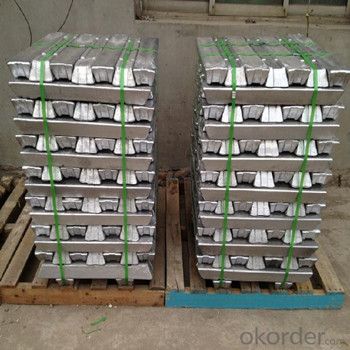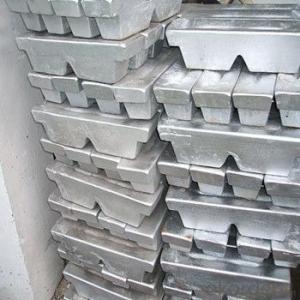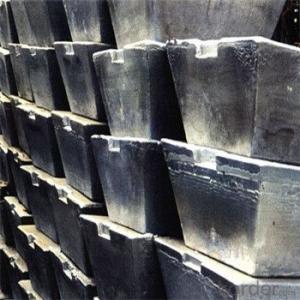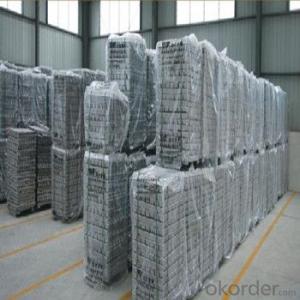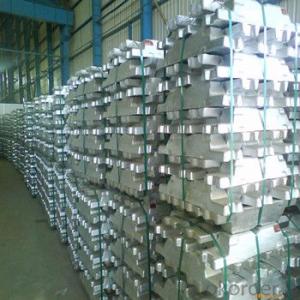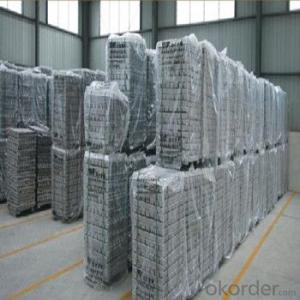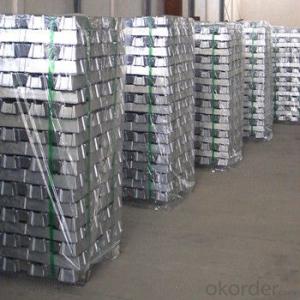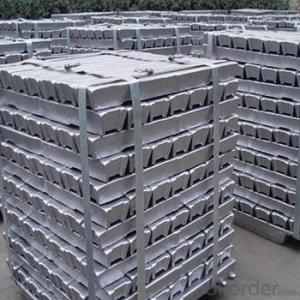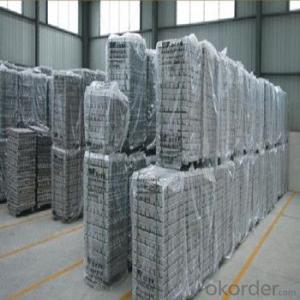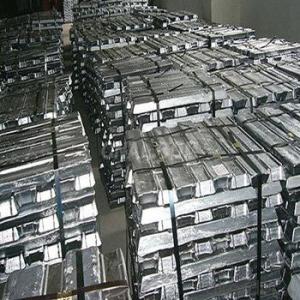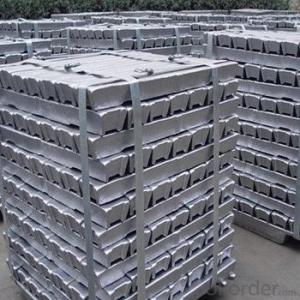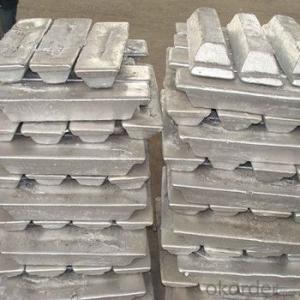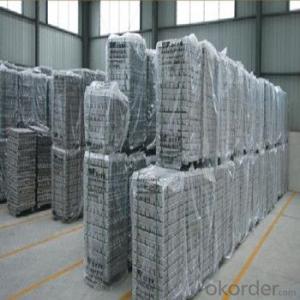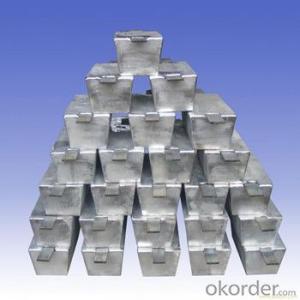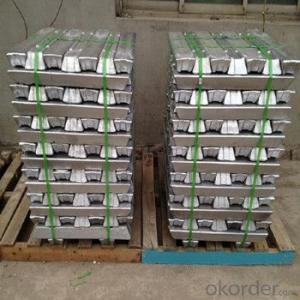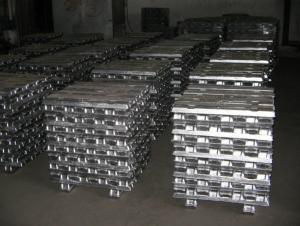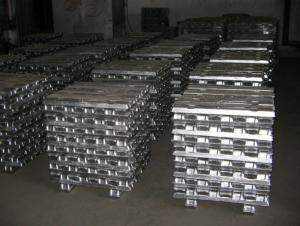Aluminum Pig/Ingot With 99.7% 99.9% Purity
- Loading Port:
- China main port
- Payment Terms:
- TT OR LC
- Min Order Qty:
- 1000 m.t.
- Supply Capability:
- 100000 m.t./month
OKorder Service Pledge
OKorder Financial Service
You Might Also Like
Pure Aluminum Pig/Ingot Used for Industry
1.Structure of Aluminum Pig/Ingot
A material that has been cast into a shape in order to be transported and processed easier than in an unprocessed form. An ingot is typically rectangular in shape, which allows it to be stacked. Ingots are most commonly associated with metals, with ingots of gold held in the vaults of banks and brokerages being popular images.
Aluminum Ingot is with the AL as the main chemical composition.Aluminum Ingot is used for industry,such as automobile,pinning and weaving,electron broadly and so on. Aluminum Ingot has the following advantages: easy control and operation, fast melting.
2.Main Features of the Aluminum Pig/Ingot
•High Purity
•Easy control and operation
•High strength
•Fast melting
•Competitive price
•Best Service
3.Aluminum Pig/Ingot Images
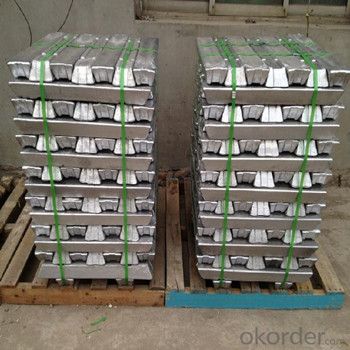

4.Aluminum Pig/Ingot Specification
Grade | Chemical Composition % | |||||||||
Al≥ | impurities ≤ | |||||||||
Si | Fe | Cu | Ga | Mg | Zn | Mn | others | Sum | ||
Al99.9 | 99.90 | 0.50 | 0.07 | 0.005 | 0.02 | 0.01 | 0.025 | - | 0.010 | 0.10 |
Al99.85 | 99.85 | 0.80 | 0.12 | 0.005 | 0.03 | 0.02 | 0.030 | - | 0.015 | 0.15 |
Al99.7 | 99.70 | 0.10 | 0.20 | 0.010 | 0.03 | 0.02 | 0.030 | - | 0.030 | 0.30 |
Al99.6 | 99.60 | 0.16 | 0.25 | 0.010 | 0.03 | 0.03 | 0.030 | - | 0.030 | 0.40 |
Al99.5 | 99.50 | 0.22 | 0.30 | 0.020 | 0.03 | 0.05 | 0.050 | - | 0.030 | 0.50 |
Al99.00 | 99.00 | 0.42 | 0.50 | 0.020 | 0.03 | 0.05 | 0.050 | - | 0.050 | 1.00 |
5.FAQ of Aluminum Pig/Ingot
We have organized several common questions for our clients,may help you sincerely:
①How about your company?
A professional manufacturers of the alumiun pig.Devoted in this industry for many years,so got much experice.The quality and service have also accepted by customer.Can meet customers' requiements to provide different grade and purity alumiun pig.
②How to guarantee the quality of the products?
We have established the international advanced quality management system,every link from raw material to final product we have strict quality test;We resolutely put an end to unqualified products flowing into the market. At the same time, we will provide necessary follow-up service assurance.
③How long can we receive the prod rking days, We will arrange the factory delivery as soon as possible. The pecific time of receiving is related to the state and position of customers.Commonly 7 to 10 working days can be served.
- Q: What are the main components of aluminum ingots?
- The main components of aluminum ingots are primarily aluminum, with trace amounts of other elements such as iron, silicon, copper, manganese, magnesium, and zinc.
- Q: Our unit is aluminum smelting enterprise, mainly producing aluminum ingots. The unit adopts wet dedusting equipment, and the packing tower explodes!
- The molten aluminum fume reacts with water to produce a large amount of heat and H2. The explosion occurs because the process design does not take into account this aspect and is poor in liquid spraying. This is only preliminary estimate. Please provide the parameters of flue gas inlet tower temperature, tower temperature, spray water quantity and temperature of inlet and outlet water for further judgment.
- Q: What are the environmental benefits of using aluminum ingots?
- Using aluminum ingots offers several environmental benefits. Firstly, aluminum is a highly recyclable material, meaning that it can be melted down and reused repeatedly without any loss in quality. This recycling process consumes significantly less energy and produces fewer greenhouse gas emissions compared to the production of primary aluminum from raw materials. Secondly, aluminum ingots are lightweight, making them an ideal choice for transportation and packaging. Their low weight reduces fuel consumption, leading to lower carbon emissions. Lastly, using aluminum ingots helps to reduce the reliance on mining for raw materials, which can lead to habitat destruction and other negative environmental impacts.
- Q: What are the advantages of using aluminum ingots in the production of renewable energy systems?
- There are several advantages of using aluminum ingots in the production of renewable energy systems. Firstly, aluminum is a lightweight material, making it easier to transport and install in various renewable energy systems such as solar panels and wind turbines. This lightweight characteristic also reduces the load on supporting structures, leading to cost savings in terms of materials and installation. Secondly, aluminum has excellent corrosion resistance properties, which is crucial for renewable energy systems that are often exposed to harsh environmental conditions. This resistance ensures the longevity and durability of the systems, reducing maintenance and replacement costs. Additionally, aluminum is highly recyclable, with the ability to be reused repeatedly without any loss in quality. This recyclability aspect makes aluminum a sustainable choice for renewable energy systems, aligning with the goal of minimizing environmental impact. Furthermore, aluminum has high thermal conductivity, allowing for efficient heat dissipation in renewable energy systems. This property is particularly beneficial in applications like solar panels, where excess heat can reduce efficiency. By effectively dissipating heat, aluminum ensures optimal performance and extends the lifespan of the system. Moreover, aluminum ingots can be easily molded and customized into various shapes and sizes, enabling manufacturers to design renewable energy systems with enhanced efficiency. This flexibility in design helps optimize the system's performance and adapt to different project requirements. Lastly, aluminum is a cost-effective material compared to alternatives like steel or copper. The relatively low cost of aluminum ingots allows for more affordable production of renewable energy systems, making them more accessible to a wider range of consumers. In conclusion, the advantages of using aluminum ingots in the production of renewable energy systems lie in their lightweight nature, corrosion resistance, recyclability, thermal conductivity, design flexibility, and cost-effectiveness. These qualities contribute to the overall efficiency, durability, and affordability of renewable energy systems, making aluminum a preferred material in the industry.
- Q: What elements do alloy die casting ingots require?
- Adding a small amount of magnesium (about 0.2 - 0.3%) to high silicon aluminum alloy can increase the strength and yield limit and improve the machinability of the alloy. Aluminum alloy containing 8% mg has good corrosion resistance, but its casting properties are poor, the strength and plasticity at high temperature are low, and the cooling shrinkage is large, so it is easy to produce hot cracking and loose.
- Q: What are the different shapes and sizes of aluminum ingots?
- Aluminum ingots come in various shapes and sizes depending on the specific requirements of the industry they are being used in. The most common shape of aluminum ingots is rectangular, with a length ranging from a few inches to several feet, and a width and height that vary proportionately. These rectangular ingots are typically used in industries such as construction, automotive, and aerospace. In addition to rectangular ingots, there are also cylindrical-shaped aluminum ingots. These ingots have a circular cross-section and can have varying diameters and lengths. Cylindrical ingots are commonly used in the manufacturing of electrical components, such as wires and cables, due to their uniform shape and ease of processing. Moreover, aluminum ingots can also be found in other shapes such as trapezoidal or triangular, although these are less common and are usually customized to meet specific industrial requirements. These irregular-shaped ingots are often used in specialized applications where unique designs or specific mechanical properties are needed. The sizes of aluminum ingots can vary widely as well. Smaller ingots are typically used for smaller-scale applications or for testing purposes, whereas larger ingots are used in heavy industries where large quantities of aluminum are required. The weight of an aluminum ingot can range from a few pounds to several tons, depending on its size and intended use. Overall, the shapes and sizes of aluminum ingots are diverse and can be tailored to meet the specific needs of different industries and applications.
- Q: What are the advantages of using aluminum ingots in electrical applications?
- There are several advantages of using aluminum ingots in electrical applications. Firstly, aluminum is a lightweight metal, which makes it easier to handle and transport. Secondly, aluminum has excellent conductivity properties, allowing it to efficiently carry electrical current. Additionally, aluminum ingots are highly resistant to corrosion, making them durable and long-lasting in electrical applications. Lastly, aluminum is a cost-effective material compared to other metals, which makes it a more economical choice for electrical components.
- Q: 15% of the iron in the ingot represents 1 tons of iron
- 150 kilograms, that is equivalent to 300 pounds.
- Q: It can be dissolved aluminum cans, aluminum ingots, need what equipment?
- It is difficult to control the impurities. The impurity is difficult to control, and the purity is difficult to meet the required index, because the ingot needs the casting machine.
- Q: Can aluminum ingots be recycled?
- Yes, aluminum ingots can be recycled.
Send your message to us
Aluminum Pig/Ingot With 99.7% 99.9% Purity
- Loading Port:
- China main port
- Payment Terms:
- TT OR LC
- Min Order Qty:
- 1000 m.t.
- Supply Capability:
- 100000 m.t./month
OKorder Service Pledge
OKorder Financial Service
Similar products
Hot products
Hot Searches
Related keywords




